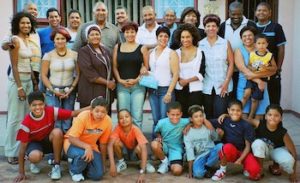
*The Coloured communities of Southern Africa are celebrated on this date in 1950.
Coloured refers to members of multiracial ethnic communities in Southern Africa who may have indigenous ancestry from more than one of the various populations inhabiting the region, including African, European, and Asian. South Africa's Coloured people have some of the most diverse genetic backgrounds.
Because of the vast combination of genetics, different families and individuals within a family may have various physical features. The Cape Coloured community descended from several interracial sexual unions, primarily between Western European men and Khoisan or mixed-race women in the Cape Colony from the 17th century onwards.
In KwaZulu-Natal, the Coloured possess a diverse heritage, including British, Irish, German, Mauritian, Saint Helenian, Indian, Xhosa, and Zulu. Zimbabwean Coloureds descend from Shona or Ndebele, British and Afrikaner colonizers, and Arabs and Asians. Griqua are also descendants of Khoisan women and Afrikaner Trekboers.
Despite these significant differences, as both groups have ancestry from more than one naturalized racial group, they are classified as coloured in the South African context. Such mixed-race people did not necessarily self-identify this way; some preferred to call themselves black, Khoisan, or South African. The Griqua were subjected to the uncertainty of other Creole people within the Southern African social order. The leader of this group, Adam Kok I, a former Creole slave of the Dutch governor, was freed and provided land outside Cape Town in the eighteenth century.
With territories beyond the Dutch East India Company's administration, Kok provided refuge to deserting soldiers, runaway slaves, and remaining members of various Khoikhoi tribes. In South Africa and neighboring countries, the white minority governments historically segregated Africans from Europeans after the settlement had progressed. During the apartheid era in South Africa of the second half of the 20th century, the government used the term "Coloured" to describe one of the four main racial groups defined by law. This was an effort to impose white supremacy and maintain racial divisions.

Individual classifications were White South Africans (formally classified as "European"), Black South Africans (officially classified as "Native," "Bantu," or simply "African" and comprising most of the population), Coloureds (mixed-race) and Indians (formally classified as "Asian"). They were referred to as Kleurlinge or Bruinmense, 'Brown people.' Coloured African people may have ethnic ancestry from Indonesia, mixed race, and Khoisan ancestry. The Apartheid government treated them as one people despite their differences. 'Cape Muslims' were also classified as 'coloured.' They generally have Indonesian and black ancestry, as many enslaved Indonesians had children with African partners.
Many Griqua self-identified as Coloureds during the apartheid era because of the benefits of such classification. For example, Coloureds did not have to carry an identity document to limit the movements of non-whites. In contrast, the Griqua, seen as an indigenous African group, did. In the 21st century, the percentage of Coloureds in the provinces of the Western Cape is 48.8%, and in the Northern Cape, 40.3%—both areas of centuries of mixing among the populations. In the Eastern Cape, they make up 8.3% of the population. Most speak Afrikaans, as they were generally descendants of Dutch and Afrikaner men and grew up in their society.
About twenty percent of the Coloured speak English as their mother tongue, primarily those of the Eastern Cape and KwaZulu-Natal. Virtually all Cape Town Coloured are bilingual. Coloureds mostly live in the western part of South Africa. In Cape Town, they form 45.4% of the total population, according to the South African National Census of 2011. The apartheid-era Population Registration Act of 1950 and subsequent amendments codified the Coloured identity and defined its subgroups. Indian South Africans were initially classified under the Act as a subgroup of Coloured.
Due to Apartheid policies and despite the abolition of the Population Registration Act in 1991, Coloureds are one of four race groups in South Africa. These groups (blacks, whites, Coloureds, and Indians) still tend to have strong racial identities and classify themselves and others as members of these race groups. The classification continues to persist in government policy, to an extent, due to attempts at redress such as Black Economic Empowerment and Employment Equity.